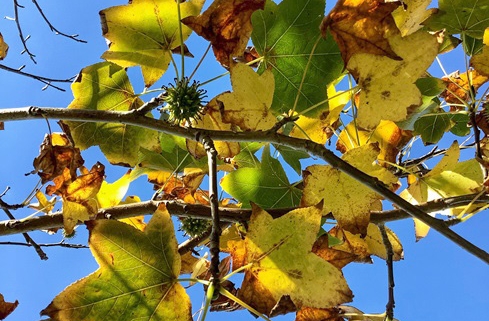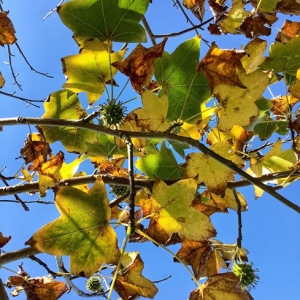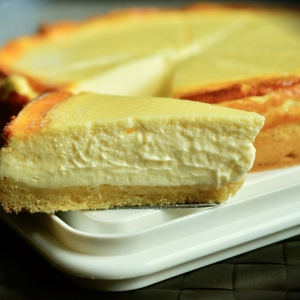Deciduous deliciousness
Winter is the perfect time to select and plant a deciduous plant in your garden. Deciduous plants are dormant during winter, making them easy to transport and plant and, at this time of year, nurseries tend to have the best selection including bare-rooted varieties that can make for a more economical purchase.
Deciduous plants drop all their leaves as an adaptation to conserve water and energy, avoid physical damage from snow and ice, regulate temperature, manage pests and diseases, and contribute to nutrient cycling. In the garden, we can take advantage of this trait.
The main advantage of having a deciduous plant in your garden is that they provide excellent shade when needed in the summer months, but they allow the sun to shine through in winter. This can be advantageous for passive solar heating and cooling of your house by locating the plant(s) on the northern or western sides. This is also useful for livestock protection (e.g. a mulberry tree in a chook pen) and for shielding sun-sensitive plants (our hydrangeas thrive underneath the protection of a big old plum tree). You can achieve the same effect with a deciduous vine run over a structure such as an arbour, pergola or vertical structure.
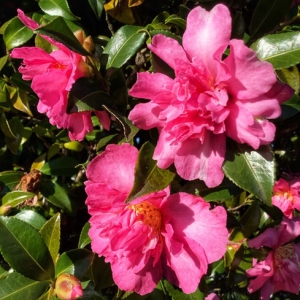 Another, aesthetic, advantage of a deciduous plant is colour. The colour change associated with the deciduous process occurs as the plant tries to reclaim as many useful components from the leaves as possible. The first ingredient to be reclaimed is chlorophyll, the light harvesting structure that give leaves their green colour. As the chlorophyll is reclaimed from the leaf and absorbed back into the plant, other chemicals and pigments in the leaves become visible as reds and yellows. Once all the elements are reclaimed, the leaf dies and falls from the tree. Spectacular colours are not just restricted to their leaves either, as many deciduous species flower spectacularly on bare branches at the beginning of spring such as Prunus spp. (Japanese cherry blossom).
Another, aesthetic, advantage of a deciduous plant is colour. The colour change associated with the deciduous process occurs as the plant tries to reclaim as many useful components from the leaves as possible. The first ingredient to be reclaimed is chlorophyll, the light harvesting structure that give leaves their green colour. As the chlorophyll is reclaimed from the leaf and absorbed back into the plant, other chemicals and pigments in the leaves become visible as reds and yellows. Once all the elements are reclaimed, the leaf dies and falls from the tree. Spectacular colours are not just restricted to their leaves either, as many deciduous species flower spectacularly on bare branches at the beginning of spring such as Prunus spp. (Japanese cherry blossom).
The third advantage of a deciduous plant/tree is the actual leaf drop itself which can be a useful resource if composted or turned into leaf mould.
There is a deciduous species to suit every sized garden from large trees (Liquidambar spp.) to small trees (Acer spp.), fruiting trees (apples, pears, peaches, plums, cherries, figs etc.) as well as vines such as grapes, wisteria, clematis, hops and even choko. So, give one a chance, embrace the season and let the winter sunshine in.
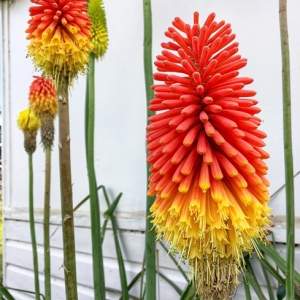 Meanwhile, around the town gardens, the hibiscus are still providing splashes of colour after seemingly endless months. The grevilleas are throwing out yet another round of flowers. Those queens of winter, the camellias, have burst into bloom, and the kniphofia spp. (red hot pokers) have begun lighting up the winter gardens like flaming torches.
Meanwhile, around the town gardens, the hibiscus are still providing splashes of colour after seemingly endless months. The grevilleas are throwing out yet another round of flowers. Those queens of winter, the camellias, have burst into bloom, and the kniphofia spp. (red hot pokers) have begun lighting up the winter gardens like flaming torches.
This month in the vegie garden, the planting options are getting a tad thin. It’s pretty much the last chance to get your garlic in and, by all means, carry on planting the alliums (onions, shallots etc.). That’s about all we will be sowing this month.
Finally, if you have any comments, gardening questions or plant or pest identification problems, please send them through to gardening@thetriangle.org.au and I will endeavour to help.
Happy growing.
